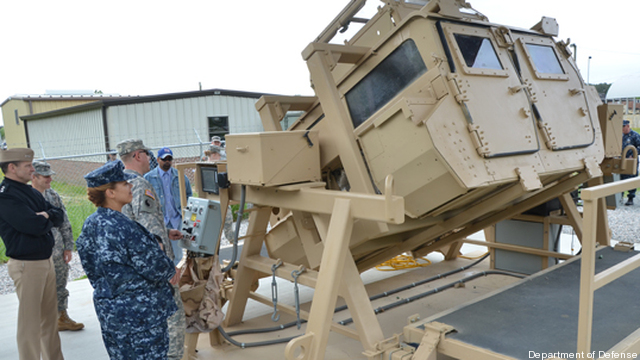Army Reserve Training Goes Digital To Save Dollars
Posted on

WASHINGTON: To squeeze the most it can out of every training dollar in an era of shrinking budgets, the Army Reserve will rely more on simulators and long-distance learning to replace traditional drill weekends, outgoing Chief of Army Reserve Lt. Gen. Jack Stulz said today. Those efficiencies, in turn, will free up funds for ambitious new efforts to do more training abroad with allies and in three state-of-the-art training centers in the US: Fort Hunter Liggett in California, Fort McCoy in Wisconsin, and Fort Dix in New Jersey.
“We’re going to have constrained resources,” Lt. Gen. Stultz , who retires this summer, told reporters this morning in a farewell conference call. While his six years as Chief of Army Reserve were a period of virtually “unconstrained” resources but never enough time in the rush to support the war effort, Stultz said, his successor Lt. Gen. Jeff Talley will face the challenge of sustaining the force affordably for the long haul. A key part of that will be a new approach to training.
The Reserve and National Guard put tremendous effort into training for Iraq and Afghanistan, but there were equally tremendous inefficiencies. Troops were sometimes mobilized, shipped away from their families and civilian jobs, and then parked on bases for months of administrative processing and repetitive, dumbed-down training before they were actually deployed. Even ordinary drill weekends can easily be consumed by administrivia and mandatory refresher classes, while realistic combat-skills training is limited by cramped facilities at reserve centers and Guard armories. The results are bad for morale and bad for the budget, neither of which the Reserve can afford in the future.
Instead, Stultz said, “we’ve got to really leverage a lot of the simulation resources we now have for training….We’ve got everything from watercraft trainers to the weapons systems trainers,” he went on. “You can put a person in a drill hall in the same environment they’ve been in Afghanistan, virtually walking through a village.”
The whole Army is intensely interested in simulators as a way to get more realistic training at a lower price — not to replace traditional field exercises but to supplement them, officials insist — but the Reserve and Guard have their own particular challenges where technology might help. Reservists live widely dispersed, not concentrated on bases, which makes distance learning especially attractive. Why does a reservist need to drive for hours to a central location just to sit through a required refresher course on (for example) the Geneva Convention, Stultz asked. “My daughter just graduated from pharmacy school at the University of Florida, [and] they didn’t go to campus for any of the lectures, all the lectures were on the computer,” Stultz said. “You go to campus for the exams and the labs” — that is, only for the activities where physical presence is essential. “I think that’s something we’ve got to look at in the reserves, how can we decentralize some of the training we’re doing, so that soldier doesn’t necessarily get in the car and drive.”
At the same time that distance learning may let the Reserves decentralize much mundane weekend training, Stultz sees opportunities to centralize the larger, more intense training events that Reserve and Guard units do just once a year. Fort Dix on the East Coast, Hunter Liggett on the West Coast, and McCoy in the Midwest are being built up as “centers of excellence” where Reserve units from across the country can train on inventories of “the latest and greatest” equipment, Stultz said. That hardware will remain at those bases for all incoming units to train on, avoiding the expense of each unit shipping its own equipment from home base to the training site.
Stultz also wants the Reserve to send more troops for training overseas with foreign partners. That’s a key part of the Administration’s new strategy and an area where Congress has approved statutory authorities that open new possibilities for the Reserve.
“With this new authority we can now send them down for much longer periods of time,” Stultz said. Historically, such overseas training had to occur within the confines of an annual training exercise, limiting it to a a few weeks; now, with the new authorities — and the reduced demand from Afghanistan and Iraq — the Reserve will be able to send troops abroad for longer and, as each unit finishes its time, rotate another one in to replace it. “It’s not going to happen overnight,” said Stultz. But the Reserve can start working with theater commanders in places like South America, Africa, and the Pacific to say, “Next year instead of 29 days, let’s do 60 days or 90 days.”
The key question, of course, is money. “Where are the resources to pay for it going to come from?” Stultz asked. “In a lot of cases they?re already there,” in various funds set aside for international exercises that the Reserves historically have not accessed. In other cases, it will have to come from savings within the Reserve’s own budget, like using more simulators and distance learning. Where it can’t come, Stultz emphasized, is from going to the rest of the Army for more money, because it simply won’t be there.
Subscribe to our newsletter
Promotions, new products and sales. Directly to your inbox.
